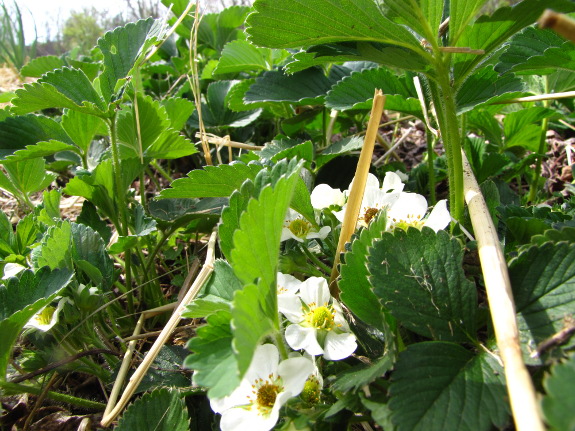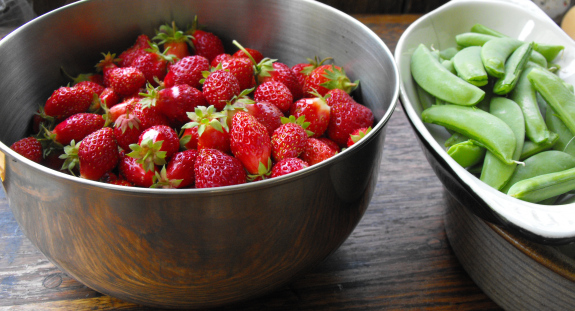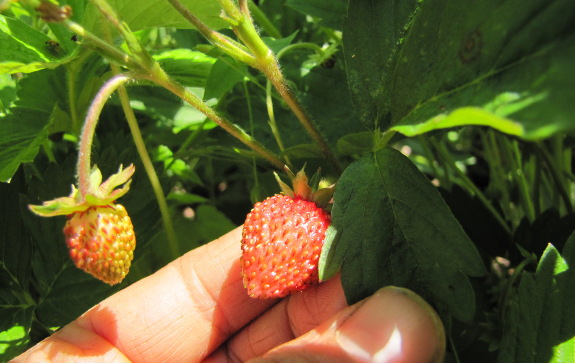
What are the tastiest strawberry varieties?

We've tried six
strawberry varieties so far, two of which I wholeheartedly recommend,
two of which were okay, and two of which were duds. Here's the
rundown (from best to worst) in case you're looking for excellent
strawberries for your own garden:
- Honeoye --- Honeoyes are very tasty and prolific. The variety is an early, June-bearing variety and usually gives us our first berries, then continues to ripen huge berries for a couple of weeks.
 Ozark Beauty --- Depending on location
in the garden, sometimes these taste even better than the Honeoyes, but
I don't like them quite as much because the berries are smaller, so it
takes more effort to harvest them. (The photo above shows a
bowlful of Ozark Beauty berries from 2010.) Although supposedly
an everbearing variety, ours simply fruit for about three weeks in
spring. (I got the plants from Wal-mart, though, so they could
easily have been mislabeled.)
Ozark Beauty --- Depending on location
in the garden, sometimes these taste even better than the Honeoyes, but
I don't like them quite as much because the berries are smaller, so it
takes more effort to harvest them. (The photo above shows a
bowlful of Ozark Beauty berries from 2010.) Although supposedly
an everbearing variety, ours simply fruit for about three weeks in
spring. (I got the plants from Wal-mart, though, so they could
easily have been mislabeled.)
- Jewel --- This is a late, June-bearing variety, meaning that it starts to ripen just as Honeoye comes to an end and turns the strawberry season into at least a month of harvest time. I ripped out our Jewel strawberries a few years ago because the flavor isn't nearly as good as the previous two varieties, but I've yet to find a tastier, late variety. Perhaps you have a suggestion for a replacement?
 Mignonette --- This is an
alpine
strawberry, meaning that you can start
it from seed, it's everbearing, and the fruits are tiny.
Unfortunately, I don't think alpine strawberries are our style --- I'm
just not willing to pick teensy fruits when the garden is so busy, and
I didn't think the flavor was as good as my top-notch
June-bearers. (The photo above is a Mignonette strawberry from
2011.)
Mignonette --- This is an
alpine
strawberry, meaning that you can start
it from seed, it's everbearing, and the fruits are tiny.
Unfortunately, I don't think alpine strawberries are our style --- I'm
just not willing to pick teensy fruits when the garden is so busy, and
I didn't think the flavor was as good as my top-notch
June-bearers. (The photo above is a Mignonette strawberry from
2011.)
- Allstar --- This was supposed to be a replacement for Jewel since it is a late, June-bearer. However, the fruits tasted like storebought berries. Beware!
- Fresca --- This is
another variety you can grow from seed, but the fruits were
awful. I ripped it out.
I'd be curious to hear
about strawberry varieties you've tried and loved. We hope to
trial yet another late, June-bearing variety this year, but haven't
chosen which kind yet. Meanwhile, you might be interested in
reading about other
factors that influence flavor of the strawberry patch if you're trying to grow the
tastiest berries you've ever eaten.
Want more in-depth information? Browse through our books.
Or explore more posts by date or by subject.
About us: Anna Hess and Mark Hamilton spent over a decade living self-sufficiently in the mountains of Virginia before moving north to start over from scratch in the foothills of Ohio. They've experimented with permaculture, no-till gardening, trailersteading, home-based microbusinesses and much more, writing about their adventures in both blogs and books.
Want to be notified when new comments are posted on this page? Click on the RSS button after you add a comment to subscribe to the comment feed, or simply check the box beside "email replies to me" while writing your comment.

Thank you for the info on your strawberries. I just planted my first crop, started with 10 smallish plants of Sequoia. I almost got AllStar but was wanting more of an ever-bearing than a June-bearing.
I may add some Quinault and Eversweet to the mix, after seeing how the first batch goes.
I would love trying out the Pine-Berries (white berry/red seeds) but those are not allowed where I live.
I'd second Ozark Beauty for the everbearing category. I'd also recommend Tribute for the day neutral category.
It almost pains me to check your blog lately with all the blooms and greenery - was out running on the lake yesterday and inquired on the ice quality from the fisherman, who informed me it was holding up well, almost four feet thick! My strawberries are still under snow and its almost May - but I did check under the hood and the meristems are still green... strawberries for late July I suppose.
I've had great luck with Ozarks up here - very hardy and they spread like wildfire once they get going. I tried both Quinault and Sequoia, but they never overwintered. Also added a wild strawberry hybrid that ripens pink to salmon colored - not terribly sweet, but proflific and makes great jam.
Kathleen --- Good question! That really deserves its own post, but I'll answer here quickly instead. I keep track of all my plants by numbering each bed and then using a spreadsheet to tell what I planted where when. Then, once a year, I go through and see which strawberry beds are more than three years old. Those come out and get replaced by new beds, which I usually fill with newly rooted plants from the old beds (unless I'm starting new varieties). I've found that by setting out strawberries in the middle of the summer (then watering them well), we can eat from those beds the next year rather than breaking my heart by picking off flowers while the plants get established.
You might also be interested in this post about the bed renovation I do every year to keep the younger strawberry beds in good shape.